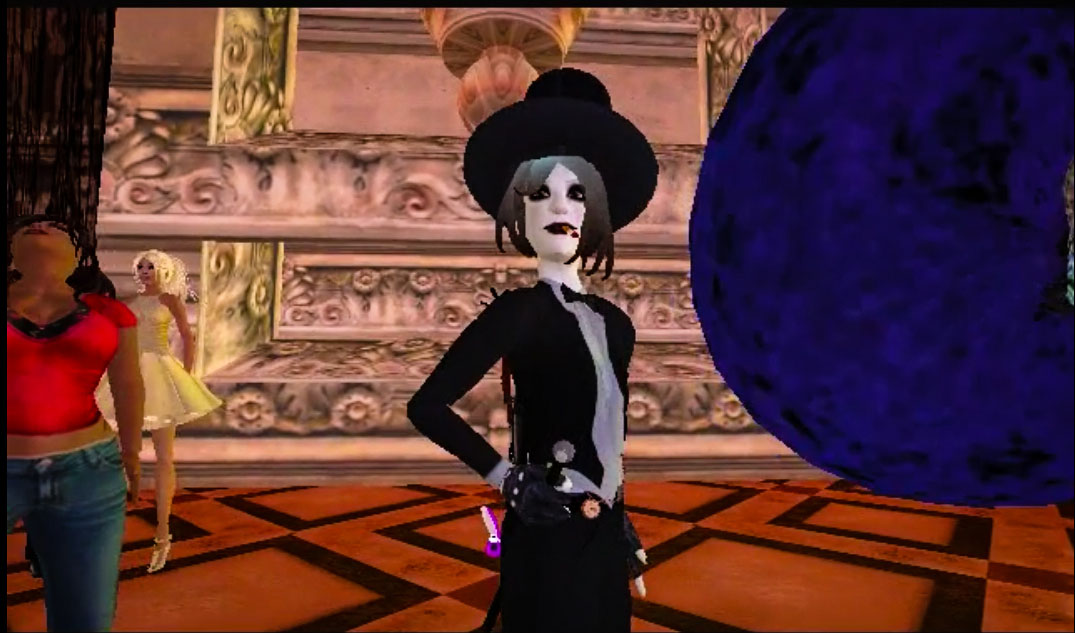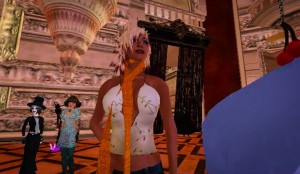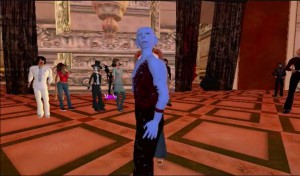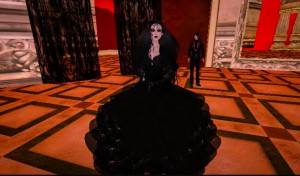2014
ARTICLE
ARTICLE
From Plaid Zebra
Link: https://theplaidzebra.com/second-lifes-avatar-orchestra/

 Then, they stop talking and begin to rotate as they lightly ascend into the air as a subtle whoosh sound creeps in. In a few minutes, they’re all airborne, the sounds get louder and more intense, and the band’s first piece has begun in earnest.
Then, they stop talking and begin to rotate as they lightly ascend into the air as a subtle whoosh sound creeps in. In a few minutes, they’re all airborne, the sounds get louder and more intense, and the band’s first piece has begun in earnest.
 Second Life as a program is a real patchwork job; it’s a marvel of modern engineering, able to connect and support a user base of one million, but its decade-old infrastructure shows in the regularly poor frame rate and simple polygonal avatars. There’s a sense that the virtual world is seconds away from crashing at all times.
Second Life as a program is a real patchwork job; it’s a marvel of modern engineering, able to connect and support a user base of one million, but its decade-old infrastructure shows in the regularly poor frame rate and simple polygonal avatars. There’s a sense that the virtual world is seconds away from crashing at all times.
 The difficulties of Second Life performance aren’t so different from being in an ensemble in real life, though. With any collective that deals in conceptual performance art and challenging avant-garde music, an audience can be tough to find, so it’s no wonder that the Avatar Orchestra Metaverse exists at the fringes of Second Life. “We’re definitely not acknowledged by Linden Labs, the people who run Second Life,” Pearson says. “I think part of it is that we’re doing things that aren’t necessarily entertaining.”
The difficulties of Second Life performance aren’t so different from being in an ensemble in real life, though. With any collective that deals in conceptual performance art and challenging avant-garde music, an audience can be tough to find, so it’s no wonder that the Avatar Orchestra Metaverse exists at the fringes of Second Life. “We’re definitely not acknowledged by Linden Labs, the people who run Second Life,” Pearson says. “I think part of it is that we’re doing things that aren’t necessarily entertaining.”
2010
ARTICLE
Link: https://theplaidzebra.com/second-lifes-avatar-orchestra/
This Band Practices Weekly But Has Never Met In Person: Second Life’s Avatar Orchestra
BY: DANIEL KORN
You make your way to the concert hall and take your seat. The performance space is a grassy field in the middle of a mountainous enclosure, surrounded on all sides by a baby blue sky filled with clouds that resemble three-dimensional brains and medical diagrams of frog legs.
The band sits in the middle of the field on benches made of tree logs. A tall, bearded man is flanked by a blue-skinned gender-neutral genie and a goth woman with teased hair sporting a leather trench coat ripped right out of The Matrix. Then there’s the thin, gangly individual whose sharp features and pastel-coloured garb make her look more like a Picasso painting than a human; some sort of fish-man; and the gargantuan red-spectacled pimp wearing a top hat.
This is just a typical performance from the Avatar Orchestra Metaverse, a new media collective that performs entirely within the long-running online virtual world of Second Life. The 10-plus members of the group—located anywhere from Canada to Germany—are a varied mishmash of artists, including computer programmer and linguist Andreas Muller, influential electronic music pioneer Pauline Oliveros, and contemporary composer and performer Tina M. Pearson. Pearson, whose avatar goes by the name Humming Pera, handles much of the coordinating of the ensemble. But, as she claims with a chuckle, “there cannot be a leader.”
The group has been around since 2007, but Pearson didn’t join right away. She and many of the other group members weren’t previously involved in Second Life. “It’s more from being interested in the idea of working in a virtual world,” says Pearson. “Our interest is really in what we can do in this particular environment at the moment.”
 Second Life as a program is a real patchwork job; it’s a marvel of modern engineering, able to connect and support a user base of one million, but its decade-old infrastructure shows in the regularly poor frame rate and simple polygonal avatars. There’s a sense that the virtual world is seconds away from crashing at all times.
Second Life as a program is a real patchwork job; it’s a marvel of modern engineering, able to connect and support a user base of one million, but its decade-old infrastructure shows in the regularly poor frame rate and simple polygonal avatars. There’s a sense that the virtual world is seconds away from crashing at all times.
When you’re manipulating the game to play music, this is even more apparent. Second Life isn’t built to allow for musical creation of any kind, so performing involves creating instruments from scratch by uploading samples and attaching them to a HUD that the avatar can “wear” like any piece of clothing (they can include anything from basic keyboards to number-based inputs to in-game masks). Notes are also programmed to correspond with pre-made visuals, so triggering a sound will often cause a flash of colour or an enthusiastic dance move from an avatar. These intense demands, coupled with the shakiness of a multi-person internet connection, sometimes don’t play well with Second Life’s infrastructure.
“THE FIRST GIGS I WAS AT, YOU COULD COUNT ON A FEW THINGS HAPPENING DURING THE GAME,” PEARSON SAYS. “AT LEAST THREE OR FOUR OF US WOULD CRASH, AT LEAST FIVE OR SIX TIMES…. WE’VE MINIMIZED HOW MUCH WE USE THE VOICE CHAT FOR LONG TONES AND SINGING, BECAUSE IT JUST CUTS OUT SINCE IT’S DESIGNED FOR SPEECH. WE ALSO DON’T PLAY THINGS THAT NEED A SPECIFIC RHYTHM. WE’RE USING SECOND LIFE AS AN INSTRUMENT, SO IT’S THE REALITY OF THE SITUATION. IT’S LIKE HOW, IF YOU HAVE A PIANO, YOU’RE NOT GOING TO EXPECT TO PLAY WHAT YOU WOULD PLAY ON THE ORGAN.”
The group also has to deal with the realities of Second Life culture. Members are often “griefed” while playing; individuals will come into their area and begin to build structures that interfere with the performance. While Pearson contends that they’re “always laughing” when these sorts of things happen, it causes havoc during real-life events where they project their performance onto a screen (consequently, some events have been closed off to the Second Life public). These performances also sometimes involve musicians outside of the virtual world; at 2012’s Newfoundland Sound Symposium, Pearson accompanied the orchestra onstage with her accordion.
It’s remarkable, then, that the group has stayed together for seven years, coordinating international schedules to meet for practice every week (every Tuesday in The Odyssey Contemporary Art and Performance Simulator in Second Life, if you’re interested). Credit that to the same thing that keeps most successful bands running: a strong personal bond that comes with collaborating creatively with like-minded individuals.
“THERE’S A GENUINE SENSE OF WANTING TO STAY CONNECTED WITH ONE ANOTHER AS HUMAN BEINGS,” PEARSON EXPLAINS. “THERE ARE THINGS THAT I CAN DO IN THE ORCHESTRA, IN TERMS OF A VERY DEEP MENTAL CONNECTION, THAT I CAN’T DO IN REAL LIFE, WHICH REALLY SHOCKED ME. I HAVEN’T MET MOST OF THEM, BUT WE ALL SAY THIS: WE FEEL VERY CONNECTED TO ONE ANOTHER…. THERE’S A GENUINE LOVINGNESS WITHIN THE GROUP—PEOPLE ARE REALLY FEELING AFFECTION AND FONDNESS FOR ONE ANOTHER.”
And while the world may be virtual, the feeling of performance is very real: “I have the same kind of acute sense that my perceptions are heightened. I’m really in supreme performance mode. But then the performance is over, and I’m just sitting there in my office with my computer.”
+++++++++++++++++++++
2010
ARTICLE
Visions of Sound: Avatar Orchestra Metaverse
by Tina Pearson (aka Humming Pera)
by Tina Pearson (aka Humming Pera)
Originally published in Musicworks magazine Issue 106, March 2010.)
Link to Full article
Avatar Orchestra Metaverse
Image by: Norman Lowrey
Avatar Orchestra Metaverse is a global collective making new music within the virtual-reality platform Second Life, an online three-dimensional program that allows users to interact through in-world avatars (users’ digital representations within a given online environment).
The Orchestra had its beginnings in early 2007 with the coalescence in Second Life of a group of European musicians, artists, and engineers who were trailblazing practices of networked performance made possible with rapid advances in Internet technologies and software, and with easier access to portable computers and audio gear. The group quickly attracted collaborators from Asia and North America. The Orchestra is now a group of twelve core members scattered geographically through seven countries, using Second Life as a networked meeting ground, a performance venue, and an environment for the creation of previously unimagined instruments and interactive audio-visual presentations. The Orchestra embraces an open-to-all playing field, with musicians and composers being joined by intense listeners from other disciplines (new media, visual arts, architecture, poetry, sculpture, dance), who bring new perspectives on working with sound, plus an informed approach to the visual manifestations of idea, concept, and sound.
Read more in the print edition.
REVIEW
Avatar Orchestra makes magic
Avatar Orchestra Metaverse performance March 27, 2010 at Sea Turtle Island in Second Life. Review by Michael Peters on his Time Stands Still blog (Photos by Jeff Duke)The concert was organized by AOM member Flivelwitz (Tim Risher) and was performed by
Flivelwitz Alsop (Tim Risher, North Carolina)
Bingo Onomatopoeia (Andreas Mueller, Bavaria)
Humming Pera (Tina Pearson, British Columbia)
Maxxo Klaar (Max D Well, Bavaria)
Zonzo Spyker (Vivian Corringham, Minnesota)
North Zipper (Norman Lowrey, New Jersey)
Gumnosophistai Nurmi (Leif Inge, Oslo)
BlaiseDeLaFrance Voom (Biagio Francia, Agropoli)
Paco Mariani (Chris Wittkowsky, Bavaria)
Lizsolo Mathilde (Liz Solo, Newfoundland)
The four compositions performed were Bjorn Eriksson's Fragula, Tina Pearson's PwRHm, Tim Risher's Ritual and Andreas Muller's Aleatricity.
Time Stands Still: My Avatar is Not Blue
by Michael Peters
"I went to an amazing concert yesterday - while sitting at home. Or shall we say, as my 'real' body was sitting at home? I was watching the performance while sitting in some kind of amphitheatre, surrounded by two or three dozen of very strange other people. Maybe I was the strangest of all because I didn't even look like a human - for some reason, the avatar that I had chosen looks like a fox.
Since my first login to Second Life a couple of years ago, I had not spent much time there - I always thought it was a nice thing in theory, but disappointingly clunky in reality. I had originally come here with ideas of cyberspace (as William Gibson coined it) or the metaverse (as Neal Stephenson called his version), some other kind of immersive reality full of wonder (as if our regular reality wasn't full of wonder).
Second Life was obviously inspired by these ideas, and even though we still can't directly plug in using some kind of firewire plug in our heads, and instead have to type on keyboards and look on screens, and even though the graphics are far less perfect than I had expected, it has evolved (since its launch in 2003) into an amazing huge parallel universe full of people that interact in many ways (I read that about 60,000 people are logged in at any given moment) , and more places than one can ever visit.
Usually while my fox avatar had explored SL, he was more or less alone - I seem to be drawn more towards the lonely island than towards a busy bar full of strangers. It was nice yesterday though to be in the audience with at least one person that I knew (Jeff Duke, a fellow loop musician from Florida, who also took two photos during the performance - see below).
The Avatar Orchestra Metaverse is a collective of musicians from all over the world, one of them being Pauline Oliveros, to my surprise, a key figure of avantgarde music, livelooping, and deep listening. The orchestra has weekly rehearsals and performs in Second Life, but sometimes also in "First Life". For their Second Life performances, special technology has been developed such as virtual instruments and interactive animations.
The concert yesterday lasted for about one hour. The orchestra consisted of about a dozen musicians this time (with funny Second Life names such as Flivelwitz Alsop, Bingo Onomatopoeia, Humming Pera, Gumnosophistai Nurmi, BlaiseDeLaFrance Voom), playing four compositions by four composers who also did the conducting. The performances were a mixture of very different kinds of electronic sounds, movements, and animations, and I found that I was quickly drawn into their special virtual reality kind of magic and the astonishing dynamics of the pieces.
Something interesting, but hard to describe, happens when one suddenly forgets about the virtuality of this, and gets drawn into this world, which is, after all, populated by avatars of real people. Amazing how quickly the brain gets adjusted to something that is so different to our usual reality. It felt similar to sitting in a really fascinating movie and forgetting about sitting in a movie theatre.
Getting out of this, and back into ordinary reality: the brain switches back, but it takes some minutes. Until then, I wonder about the amazingly high resolution of the trees on the hill and how smoothly I can move across the terrace."
2007
by Michael Peters
"I went to an amazing concert yesterday - while sitting at home. Or shall we say, as my 'real' body was sitting at home? I was watching the performance while sitting in some kind of amphitheatre, surrounded by two or three dozen of very strange other people. Maybe I was the strangest of all because I didn't even look like a human - for some reason, the avatar that I had chosen looks like a fox.
Since my first login to Second Life a couple of years ago, I had not spent much time there - I always thought it was a nice thing in theory, but disappointingly clunky in reality. I had originally come here with ideas of cyberspace (as William Gibson coined it) or the metaverse (as Neal Stephenson called his version), some other kind of immersive reality full of wonder (as if our regular reality wasn't full of wonder).
Second Life was obviously inspired by these ideas, and even though we still can't directly plug in using some kind of firewire plug in our heads, and instead have to type on keyboards and look on screens, and even though the graphics are far less perfect than I had expected, it has evolved (since its launch in 2003) into an amazing huge parallel universe full of people that interact in many ways (I read that about 60,000 people are logged in at any given moment) , and more places than one can ever visit.
Usually while my fox avatar had explored SL, he was more or less alone - I seem to be drawn more towards the lonely island than towards a busy bar full of strangers. It was nice yesterday though to be in the audience with at least one person that I knew (Jeff Duke, a fellow loop musician from Florida, who also took two photos during the performance - see below).
The Avatar Orchestra Metaverse is a collective of musicians from all over the world, one of them being Pauline Oliveros, to my surprise, a key figure of avantgarde music, livelooping, and deep listening. The orchestra has weekly rehearsals and performs in Second Life, but sometimes also in "First Life". For their Second Life performances, special technology has been developed such as virtual instruments and interactive animations.
The concert yesterday lasted for about one hour. The orchestra consisted of about a dozen musicians this time (with funny Second Life names such as Flivelwitz Alsop, Bingo Onomatopoeia, Humming Pera, Gumnosophistai Nurmi, BlaiseDeLaFrance Voom), playing four compositions by four composers who also did the conducting. The performances were a mixture of very different kinds of electronic sounds, movements, and animations, and I found that I was quickly drawn into their special virtual reality kind of magic and the astonishing dynamics of the pieces.
Something interesting, but hard to describe, happens when one suddenly forgets about the virtuality of this, and gets drawn into this world, which is, after all, populated by avatars of real people. Amazing how quickly the brain gets adjusted to something that is so different to our usual reality. It felt similar to sitting in a really fascinating movie and forgetting about sitting in a movie theatre.
Getting out of this, and back into ordinary reality: the brain switches back, but it takes some minutes. Until then, I wonder about the amazingly high resolution of the trees on the hill and how smoothly I can move across the terrace."
2007
ARTICLE
Avatar Orchestra Metaverse
Written by Zubbie Capalini., 2007
Images courtesy of AOM. (Image 1) Loop Luo, (Image 2 & 5) Bingo
Onomatopoei, (Image 3 & 4) Sugar Seville.
Avatar Orchestra Metaverse (AOM) are a core group of composers, musicians
and sound artists who come together to perform live gigs on instruments they’ve
built themselves. So far so oh hum you say, except that in this case these guys
perform exclusively in the virtual world of Second Life, through their avatars.
But rather than trying to recreate Real Life (RL) instruments to perform RL music,
AOM are adamant that “we try to concentrate on the strengths of SL, that is
spatial sound, worldwide communication and immediate contact to potential
collaborators. The composition itself usually means that somebody has an idea,
generates some samples, we see how they sound when played by the orchestra
and then Bingo will build an instrument to play them, together with some means
of visualising the point when the single avatar plays back a sound. And: yes, we
often have scores, but more in a modern John Cage way. Most of the time we
follow a conductor, but this is also done in a more modern, improvisational
approach.”
According to AOM member Gumnosophistai Nurmi, “an apparent factor
distinguishing Avatar Orchestra Metaverse from other musical events within
Second Life is that they realize that the common props, the look alike instrument
the performer looks like it is playing on, will never be anything but props in
Second Life. This gives them the opportunity to also employ other ways of
visualizing the sound performance, and indeed the orchestra counts among its
members programmers, architects, visual and performance artists as well as
musicians and the entire possible mixed breed. The visual aspect of a Avatar
Orchestra Metaverse concert can be a bewildering experience.”
As Bingo Onomatopoeia explains, the orchestra uses tools afforded by the multiplayer gaming platform to play together from remote locations:
“The instruments are seen and operated by the performer as controls on the
screen, in vehicles and games this is commonly named a HUD (Head Up
Display). The single notes/sounds are triggered with the mouse. For most
instruments we have visualisation-devices - a gadget worn on the back of the
avatar that changes shape and color when a note is played. The latest
improvements are animations that move the avatar in sync with the notes. This is
not necessary for generating the music itself, but it is an important clue for the
audience about what is happening: We usually mix into the audience, so there is
no stage/audience situation with known instruments or orchestra-roles that
makes it clear who is doing what at which particular moment. I think this is one of
the big advantages of SL: We can create completely new settings for our
performances and are in direct contact with our listeners. “
And because of the nature of the internet, whilst the orchestra performs
composed pieces, there is always an element of improvisation since, as
Gumnosophistai points out: “the ever present time delays affecting all use of
broadband cooperation will also add to the indetermination here. Simply put, it
takes time from playing the sound to hearing the sound. Even if the orchestra
perform composed pieces and do attempt to follow a score and a conductor, all
the factors in live performances are dependent on both the performers and the
environment. It will never achieve the same piece sound exactly the same each
time. By not only accepting these limitations, but also embracing them, the Avatar Orchestra Metaverse approach Second Life as the instrument itself. “
The result is a blend of acousmatic and electronic music, experimental in every
aspect, and it makes for a great listening, and interactive, experience.
Second Life is providing a new platform and a new audience for musicians, and
many are embracing it as an opportunity of streaming Real Life musical events.
The Royal Liverpool Philharmonic Orchestra has recently announced such an
event, and we will be able to see and hear a Real Life live performance in a
virtual philharmonic hall in Second Life. AOM takes the opposite approach.
Their live concerts in Second Life are usually timed to be part of a Real Life
festival somewhere, so that the Real Life audience can watch the performance
on screen in real time.
But it’s not quite the same as being “inworld” as Gumnosophistai explains: “The
audience experience in Second Life is essential to the performances of Avatar
Orchestra Metaverse. As a listener to inworld performance you will hear the
music according to where you place yourself with respect to the performers. You
will hear the performer close to you better than you will hear the performer further
away. With both the performers and you the listener moving around in space, you
practically engage in a live sound installation, making a concert very much a
three dimensional listening experience.”
Taking that one step further, Miulew Takahe tells us “maybe the future plans
include playing live with all orchestra members on a Real Life location - with
some RL copies of our SL instruments.!!! Yes - truly we are discussing this, and
it would be a very nice thing to do.”
The core members of the Avatar Orchestra Metaverse are: Maximillian
Nakamura (in RL Shintaro Miyazaki in Germany), musician, composer founded
the orchestra in February 2007. Hars Hefferman (aka Harold Schellinx in RL in
France), composer, writer who was originator of the first publicly performed piece
called Vicky´s Mosquitos #13. Miulew Takahe (in RL Björn Eriksson in Sweden),
musician and sound artist, Bingo Onomatopeia, (in RL Andreas Müller in
Germany), musician and programmer, Wirxli Flimflam (in RL Jeremy Owen
Turner in Canada), composer and performance artist, Gumnosophistai Nurmi (in
RL Leif Inge based in Oslo, Norway), sound artist, composer.
Find out more (and have a listen!) at:
http://avatarorchestra.blogspot.com
http://www.myspace.com/avatarorchestra
Avatar Orchestra Google Group: http://groups.google.com/group/aom_sl


